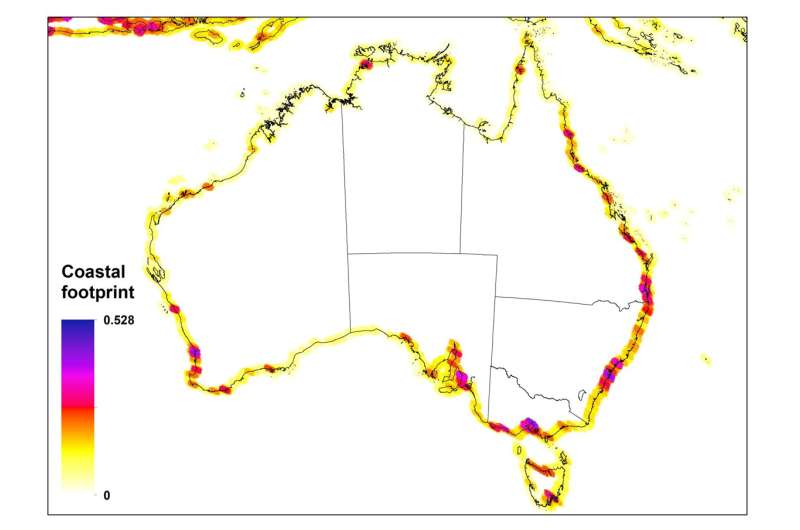This article has been reviewed according to Science X's editorial process and policies. Editors have highlighted the following attributes while ensuring the content's credibility:
fact-checked
trusted source
proofread
Stressed out: Mapping the human footprint on coastal areas globally

A global mapping project led by University of Queensland researchers has revealed the major stressors placed upon global coastlines by human activity.
The team quantified and mapped the presence and extent of major land-based and marine stressors, finding that 97 percent of coastal areas globally had at least one major stressor present.
Professor Salit Kark from UQ's School of Biological Sciences said the research team were surprised at the sheer extent and far-reaching impact revealed by the footprint map created.
"There is hardly anywhere on the planet, outside of the polar and arctic regions, that does not show some form of human pressure on their coastline," Professor Kark said.
"In essence, we have influenced the majority of coastal areas globally."
"We therefore should aim to map and understand our impacts, and also leave some untouched coastlines."
UQ Ph.D. candidate Hannah Allan said the research outlined the spatial extent and magnitude of 10 major land-based stressors and 10 major marine stressors that occur across coastlines globally.
"The threats human activity pose to coastal ecosystems and biodiversity come from both the land and sea, sometimes arriving far from human activity," Allan said.
"Therefore, coastal conservation must incorporate land-sea connections."
"Human population size, tourism, and roads were some of the biggest contributors to the terrestrial component of Australia's coastal human footprint."
"As for marine stressors, increasing sea surface temperatures, nutrient pollution, and shipping were found to be major drivers of human pressure on Australian coastlines."
Professor Noam Levin said a map of this kind, which assembles both terrestrial and marine stressors and presents the coastal human footprint globally, has rarely been attempted.
"This research offers valuable insights that could help decision-makers and managers identify where to mitigate particular impacts," Prof. Levin said.
"For example, the database underlying the human footprint can show specific areas with high oil and gas operations, such as in Western Australia."
"This can help develop preparedness procedures for the very realistic chance of environmental disasters that impact coastal areas, such as oil spills."
"An added benefit of our new global map is that it helps prioritize these decisions based on how widespread the potential pressures of our human footprint in certain areas of the world might be."
"Coastal areas, where 90 percent of Australians live, were not immune to these stressors."
"For Australia, the highest human footprint was found in the coastal cities, in the order of Melbourne, Sydney, Perth, Adelaide, and Brisbane."
"We also mapped 160 areas on the planet with the most pristine coastal areas, including several in Australia."
"Of those, nearly 40 percent were totally unprotected—opening an opportunity to identify coastal areas for further conservation actions."
"A key finding was that light pollution is increasing, with more white LEDs being used, placing great strain on areas of high importance for biodiversity, disrupting the natural patterns of wildlife."
Moving forward, researchers are looking to fine-tune the mapping process, looking more specifically at Australia's coastlines.
"Our plan is to develop high-resolution coastal footprint mapping for specific coastal areas in Australia, using finer detailed layers that are currently not available at a global scale," Professor Levin said.
This research is published in Ocean & Coastal Management.
More information: Hannah Allan et al, Quantifying and mapping the human footprint across Earth's coastal areas, Ocean & Coastal Management (2023). DOI: 10.1016/j.ocecoaman.2023.106476
Provided by University of Queensland




















